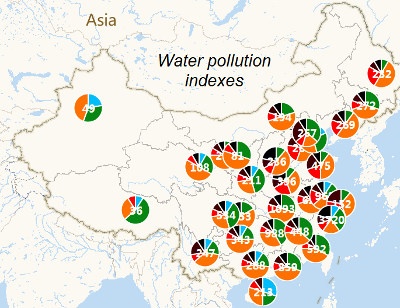Best in Manufacturing – January 7, 2018
Each Sunday, we publish a list of top articles and other content related to manufacturing in areas like quality control, product development, supply chain management, sourcing, auditing and law.
1. Are interns slaving to make your electronics?
In my mind, an intern is someone learning the ropes at a company. They’re employees that have the prospect of future full or part-time work. Unfortunately, a handful of employers abuse interns. Companies lure interns with promises of valuable experience (sometimes minus the pay) that will help them get ahead in their career. But what exploited interns quickly discover is that they are nothing more than a “coffee gopher” or copy machine attendant.
 For some workers in China, the drudgery and exploitation take a twist: working on assembly lines.
For some workers in China, the drudgery and exploitation take a twist: working on assembly lines.
As this featured article reports, some “interns” in China are simply cheap student labor for factories. Companies that use these workers are not obligated to pay medical insurance and unemployment benefits. Bosses can easily dismiss the interns, whereas full time employees are harder to fire. To top it all off, the interns are underpaid.
Major firms, like Foxconn and Quanta (Apple suppliers), have come under fire for allegedly using this employment scheme.
From the featured article:
Foreign-contracted Chinese firms exploit young workers as disposable seasonal labor required to work long illegal overtime hours to meet peak-season production demands…, at the expense of their families, the school system, and low-wage workers of all skill levels.
Hiring “interns” is a quick, cost-effective way to skirt the law and save some cash, all while meeting production quotas. For importers that wish to avoid working with factories that use this hiring practice, they should conduct social compliance audits to determine the presence of “intern” workers.
Wondering more about “intern” abuse in Chinese manufacturing? Check out the featured article in the link below:
China's Workers and the Emerging Intern Class – Michelle Chen, The Asia-Pacific Journal
2. Ideas to handle seasonal business fluctuations
For some companies, product demand comes in waves according to what time of the year it is. Leading up to the peak seasons for these companies, there’s tremendous pressure on the supply chain to deliver. There’s also pressure to get goods out the door as quickly as possible during this time because the rest of the year lacks other prime selling opportunities.
Ritsuo Shingo, the son of the man who helped design the legendary Toyota Production System, thinks differently about the seasonality of selling goods. He suggests sales and marketing departments should implement schemes that reduce the severity of seasonal sales variance and allow business to thrive throughout the year.
Of course, if your main product is Halloween or Christmas decorations, or something that is truly dependent on the seasons, you have an understandable excuse. But for everyone else, there’s less leeway.
This article mentions three companies that followed Shingo’s advice and as a result are less dependent on seasons for sales. I’ll reference one story below.
In the 1990s, Nike followed two footwear seasons: spring and “back to school”. Nike eventually convinced its suppliers to use a four-season program. This change allowed the company to spread its product launches across the entire year. And now, roughly 25 years later, Nike releases products almost monthly and has changed the seasonality of the entire footwear industry with its supply chain strategy.
Are you curious about the ways other companies reduced the impact of purchasing seasons on their businesses? Read the article below to find out more:
How to Deal with Seasonal Fluctuations in Your Business – Dan Markovitz, Industry Week
3. A mapping tool to gauge suppliers’ environmental performance
Consumers increasingly want to know where their products are made and if they’re made sustainably. While some efforts, like the Nike manufacturing map, are a good effort at transparency, not much exists for detailing the status of the natural environment around suppliers.
Without a doubt, China is the world’s largest manufacturing country. Its merchandise exports in 2016 were roughly $1.99 trillion. But with such an abundance of manufacturing and exporting, the environment is inevitably affected.
Consumers that are concerned about environmental compliance and conditions in China, specifically, can now view a map created by the Natural Resources Defense Council and the China Institute of Public & Environmental Affairs.
The tool draws on data from the Chinese government and offers “real-time data and historical trends in air pollutions emissions and wastewater discharge”. The scope of the tool is grand: it contains data on roughly 15,000 factories.
A few notable brands, like Target, Puma and Gap (to name a few), have already agreed to be displayed on the map aside their particular suppliers.
Although some developments, like pollution-devouring bacteria, can help address environmental contamination, awareness that pollution even exists is still a major part of the problem. With this map, consumers can gain the clarity and insight they need to make more informed purchasing decisions and hold suppliers accountable.
If you’d like to learn more about this detailed tool and use it for yourself, check out the article in the link below:
NRDC Mapping Tool Links Apparel Brands to Their Suppliers’ Environmental Performance – Sustainable Brands
4. Automated product inspections
There are numerous ways importers conduct product inspection on goods before they leave a manufacturer. But one way that hasn’t been widely adopted (just yet) is using automated robotic arms to verify the quality of components and finished items.
This featured article references one company, ABB Robotics, that has created an automatic part inspector. The machine works by using a 3D white-light scanning sensor that is attached to a multi-axis robotic arm.
The combination of the arm’s agility and the sensor’s attention to detail enable a thorough and accurate inspection. The sensing technology provides millions of reference points to compare to a CAD drawing to determine nonconformances.
Industry is digitizing. As more companies embrace Industry 4.0 and all the digitization, automation and other remarkable technological benefits that it offers, those that don’t will get left behind. While automated inspection is still in its infancy and not quite widespread, it’s only a matter of time before many manufacturers are using it to reduce inspection costs and ensure product quality.
If you’d like to see pictures of the automatic inspection machine and learn more about it, check out the full article in the link below:
Inspection Automation – Derek Korn, Modern Machine Shop
5. A whitepaper on manufacturing sector pollution in China
If you have manufacturing operations in China, then you need to be prepared for how environmental issues might affect your supply chain.
 Domestic pressure has mounted for the Chinese government to enforce environmental regulations after citizens have dealt with smog, polluted rivers (see #3) and other industrial contamination for prolonged periods. In response, Beijing has started cracking down on factories that don’t comply with environmental regulations.
Domestic pressure has mounted for the Chinese government to enforce environmental regulations after citizens have dealt with smog, polluted rivers (see #3) and other industrial contamination for prolonged periods. In response, Beijing has started cracking down on factories that don’t comply with environmental regulations.
Of course, China still wants to export to the rest of the world. It doesn’t show any signs of stopping its massive manufacturing engine. But some industries in particular are being targeted by the government due to their tendency to pollute their surroundings.
Just imagine that you’re awaiting an order of jeans from China. You suddenly get an email from your supplier contact that the factory has been shut down completely because it didn’t meet environmental standards. In this case, not only have you lost a part of your supply chain, your business is also in jeopardy.
This scenario might not play out as drastically for every company. Yet if your industry is in the crosshairs of the government, it’s wise to understand manufacturing pollution in China before it affects you. Additionally, knowledge of the pollution problems in China will enable you to formulate a contingency plan.
If you’d like to read the whitepaper that covers this topic, you can check it out by following the link below:
Manufacturing Sector Pollution In China Causes And Effects: Whitepaper – Renaud Anjoran, China Manufacturing Consultants
We’re constantly scanning the web for top manufacturing stories and news. If you’d like to submit an article for consideration for our weekly Best in Manufacturing, send us a message and let us know.







